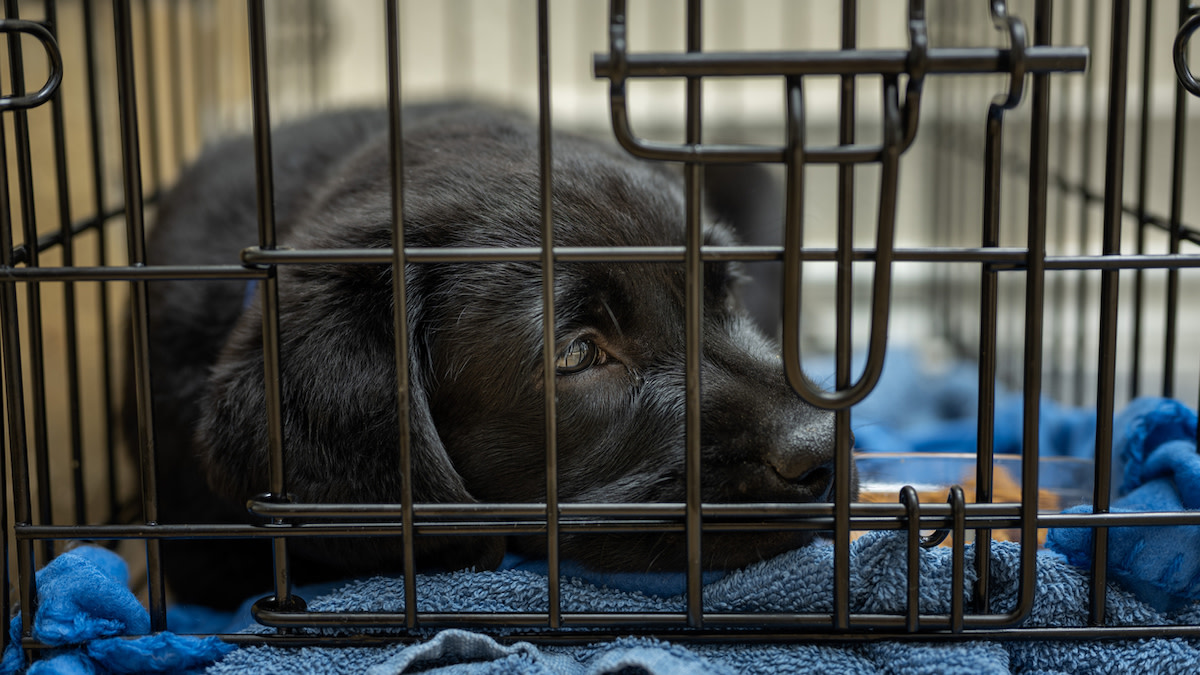
There are a couple of compelling reasons to crate train puppies. Safety at home and on the road is a big one. Ease in housebreaking is another. The arguments against crates are that they are cruel or unnecessary, but those don’t hold much water when you consider that our domestic dogs come from a long lineage of denning canids.
It’s natural for dogs to want to curl up in a confined space. This is good news for puppy owners, even though their fresh recruits likely won’t take to a crate immediately. This is why it’s crucial to understand the importance of a proper introduction, and DeadFowl Trainer, creator, and dog training legend, Tom Dokken, has it down to a science.
A Can’t-Fail Crate Introduction
“I always feed puppies in the crate while giving them the ‘kennel’ command,” Dokken said. “This helps them recognize the crate as a positive place, and teaches them to get into something on command.”
The way to a new bird dog’s heart is through its stomach, but Dokken says that watering pups in a crate is a no-no. This is because he doesn’t want the pup to spill the water in the crate, and he wants to monitor the pup’s water intake to help control the housebreaking process.
Sleep Training
In addition to feeding in the crate, pups in Dokken’s care also end up napping in them (and sleeping overnight in them). He recommends setting up the crate close enough to where you sleep to be able to hear the puppy stirring, which means it’s awake and needs to go outside. This is important because it allows you to fast-track the housebreaking process, especially if you partition off the crate so the space is small enough that a puppy won’t want to soil it.
There is a fine line here, however, because a crated pup is often an unhappy pup. And unhappy pups are often noisy pups, which can cause some issues.
“At first, puppies won’t like the crate,” he said. “They’ll make noise and fuss, but if you take them out you’ve lost the battle. You’ve trained them that they can call the shots about when they are in the crate, and they’ll use that every chance they can.”
Instead, Dokken suggests, make sure you understand that the puppy clearly doesn’t need to go out and use the bathroom. If that’s the case, let it cry itself out. Just like you would while sleep training an infant in a crib.
To make this process go smoothly, Dokken suggests keeping your pup awake and active until it’s time to go to bed. If you let your new dog nap all afternoon and into the evening, it’s not likely to go to sleep easily when you want to go to bed. Play with the pup, keep it moving, and stay engaged right before bedtime, and you’ll be much better off.
The big question here is how long this process will take. If you stick to a routine and don’t use the crate as a punishment, which creates a negative connection, you might see your dog gladly enter the crate and stay there quietly after a week or two. If you’re lax about the routine and don’t follow through with the training, it could go on for weeks or months. Or worse, never really stick.
No Need for Crating?
A lot of new dog owners go hard on the crate front for a little while but slack as the pup grows older. A dog that can be trusted can be left out during the day or overnight, but that’s up to each individual. It’s also worth noting that we often give young dogs too much freedom too quickly.
Having interviewed dozens and dozens of veterinarians in my life, this makes me nervous. A free-to-roam pup is one that is going to find something to do. They might harmlessly chew up a pillow, or they might eat something like an electrical cord that could kill them.
Pups also won’t become fur missiles if they are properly crated in a moving vehicle that is involved in an accident. And they won’t jump all over your houseguests or engage in annoying, dangerous, or damaging behavior when you can’t pay attention to them either.
Conclusion
Crates, kennels, or whatever you want to call them, are an amazing tool for training puppies and keeping them safe. They’re ideal for developing a positive nap and sleep routine, as well. But they aren’t cheap. Quality offerings will run you $400 to $500, typically. This is a buy-once, cry-once situation because the best crates are damn-near bombproof these days. Splurge on a good one and it’ll last you through multiple dogs.
If you’re still not sold, consider this—they are cheap insurance for a better, safer life for you and your new pup.



